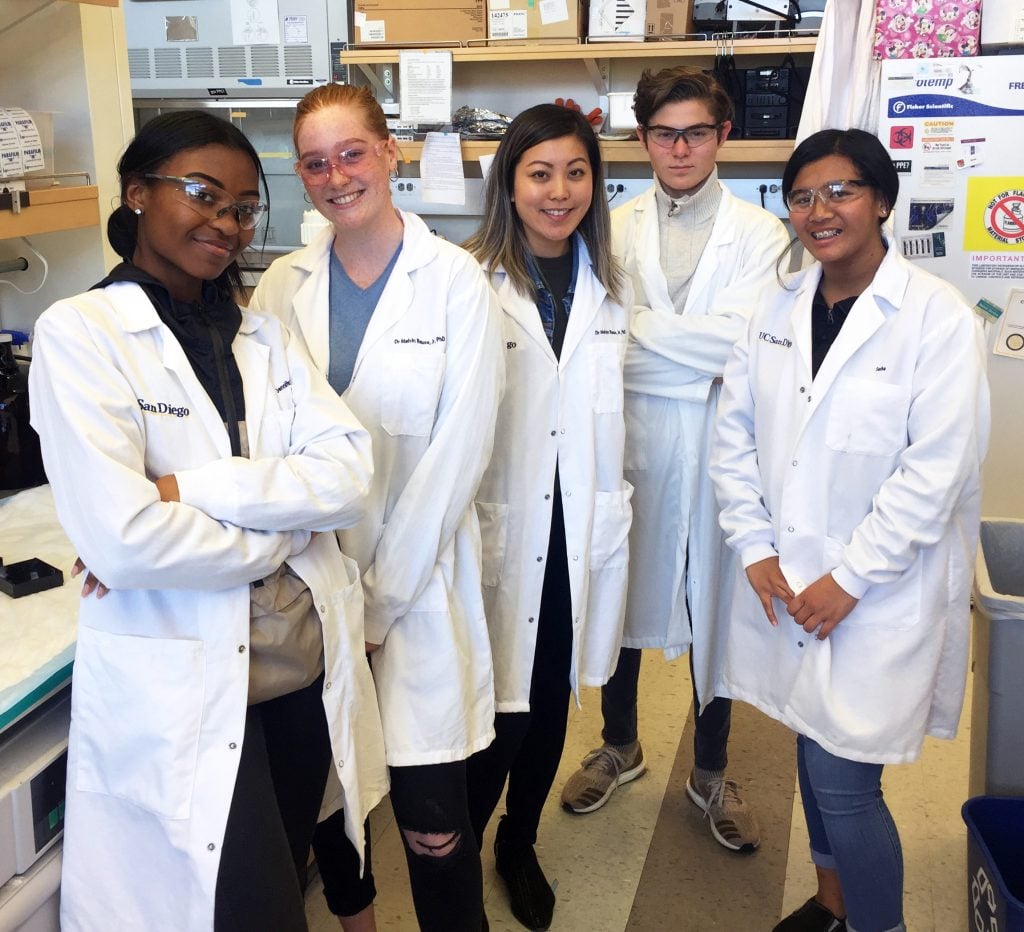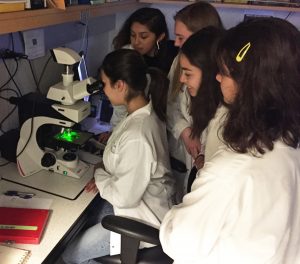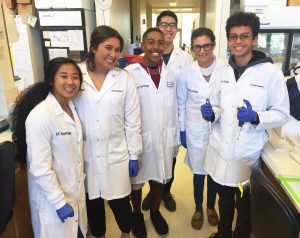
In Alexander Kauffman’s lab at UCSD, there are a few new fresh faces behind the goggles. His lab is recruiting high school students as interns to contribute “new perspectives and fearless solutions” to the traditional laboratory environment, not to mention inspiring a new generation of scientists.
Look around the laboratory of Alexander (Sasha) Kauffman, PhD, in the Department of Reproductive Medicine at the University of California San Diego (UCSD), and you’ll see a team of researchers working hard to unlock the secrets of puberty. A closer look will show that some of the researchers are barely old enough to have a drivers’ license. These young scientists-to-be are high school interns enjoying an experience with long-lasting impact.

The interns are juniors from High Tech High Chula Vista in south San Diego — a public charter school where juniors spend the month of May in full-time internships in their desired area of interest. For the past four years, several students have thrived in Kauffman’s “High Tech High Science Outreach Program” and he hopes the idea can spread to include more opportunities for youth in underrepresented communities around the country.
Nuvia C. Ruland is High Tech’s 11th grade biology/environmental science teacher and an alum of UCSD. While pursuing her science degree, she says her internship in a biochemistry lab was life changing.
“Being a Latina in science at UCSD could be very isolating, but having a supportive mentor gave me the safe space to grow as a scientist and person,” Ruland recalls. “I’m forever in debt to my high school and undergrad mentors, and I’m dedicated to pass on my passion for scientific research to my students.”
Ruland’s desire to give her students the same opportunity came to fruition when she met Kauffman, who she says jumped at the chance to partner in an internship program.

Each year, Kauffman first visits Ruland’s class to lecture about his research. Interested students then send a cover letter and resume from which he selects several to interview. Kauffman chooses two students interns who join his lab with 40-hour work weeks — many of the students spending hours of commute time on public transportation travelling the 35 miles from their homes in Chula Vista to UCSD.
“The vast majority of the interns have been underrepresented minorities, either ethnic minorities or students from low income families or a combination of both,” Kauffman says. “One of the goals that both Nuvia and I have is to increase participation of these underrepresented minorities in science and research.”
Kauffman has been involved in several outreach programs through UCSD, but says High Tech High provides the most intensive, substantial experience for the students.
“I’m forever in debt to my high school and undergrad mentors, and I’m dedicated to pass on my passion for scientific research to my students.” – Nuvia C. Ruland
“They are being trained in a whole suite of different techniques and methodologies, and they’re actually mastering many of these techniques while also coming to appreciate why we do the techniques in the first place,” Kauffman says. “So whether it’s running gels, isolating DNA, processing brain tissue onto slides, or staining for different mRNAs on brain tissue, they are getting invaluable hands-on research experience.”
“The whole experience is invaluable”
For Nicole Mendez, now a second-year student at UCSD, interviewing for Kauffman’s internship was a “nerve-wracking experience.” Her class was the first to intern in his lab.
“There was a lot of pressure to do well, not just for my own sake but for the sake of preserving this opportunity for students that came after me,” Mendez says.
Despite switching her college major from ecology to media, she says she owes a lot to the internship.

“It was really an eye opener in helping me realize what my strengths were career-wise,” she says. “Majoring in media… may seem like a big leap from an internship at Dr. Kauffman’s lab but the overall ideas and experiences still motivate me.”
“The way we constantly glean new discoveries and how similar we all are within the endocrine system and in the way we develop are some concepts that have shaped the way I approach the world,” Mendez continues. “I appreciate just how similar we all are despite the different paths we take.”
The same holds true for former intern Ethan Powers, now a freshman at San Diego State University. Powers is majoring in Computer Science with a minor in neurosciences, and says the internship in Kauffman’s lab helped him choose his direct path.
“We talked about the importance of neuroscience research and its implementations to the biomedical field,” he says. “Dr. Kauffman encouraged me to continue my appreciation for both neurosciences and computer sciences and how both can develop further advances in neuroscience research. The whole experience is invaluable, and I want to express much gratitude to Dr. Kauffman for taking his time to encourage and mentor me.”
Reaching More
Kauffman and Ruland hope to recruit neighboring research labs at UCSD to sponsor more High Tech interns. So far two others have expressed interest.
“So whether it’s running gels, isolating DNA, processing brain tissue onto slides, or staining for different mRNAs on brain tissue, they are getting invaluable hands-on research experience.” – Alexander Kauffman, PhD
“Being a high school mentor at a research institution is very challenging because of the liability of having minors in the lab,” Ruland says. “But Dr. Kauffman, as did my mentors, knows that getting youth excited in science comes through providing authentic hands-on experiences and believing in the capacity of their adolescent brain. Youth will contribute to a lab with new perspectives, questions, and fearless solutions. Having young minds in a lab is really an asset to both all those involved and the science itself.”
Kauffman acknowledges most high schools can’t offer the schedule flexibility of a four-week internship but urges there are other ways to outreach.
“Researchers could implement a summer program or an after-school program for an hour or two. Even one week would be a really valuable opportunity.”
—Fauntleroy is a freelance health writer based in Carmel, Ind. She’s a regular contributor to Endocrine News.

